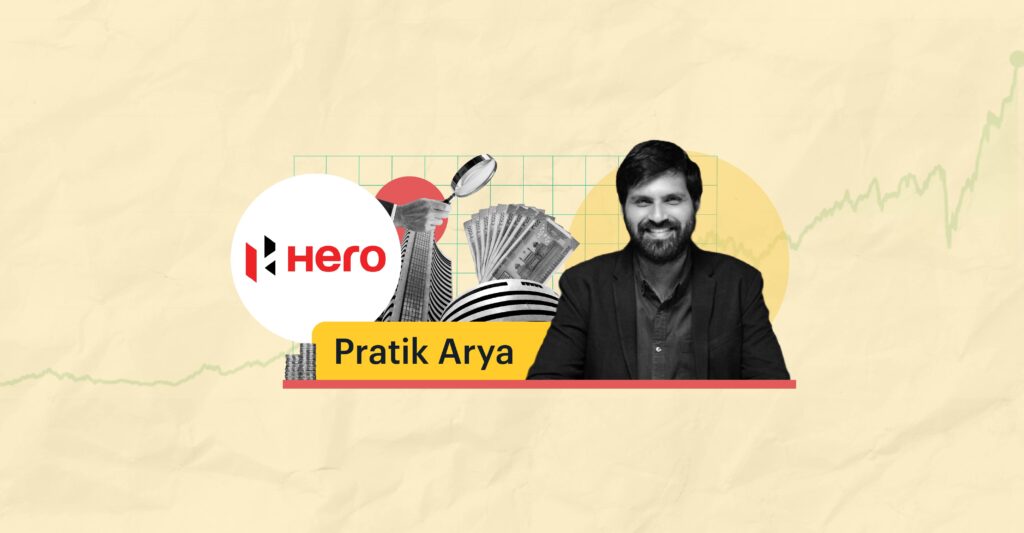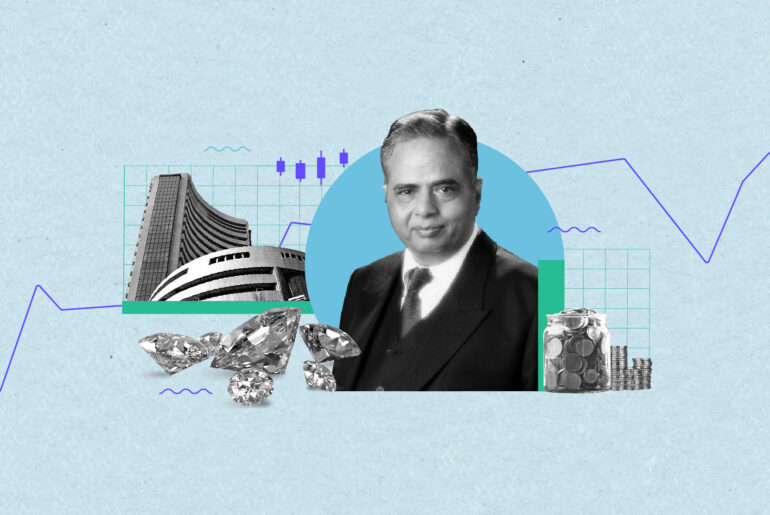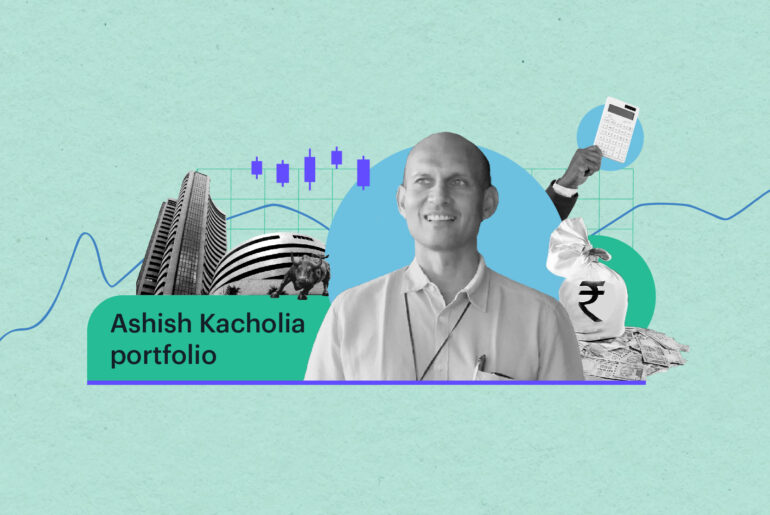Last Updated on Jul 28, 2022 by
This article is authored by Pratik Arya who spearheads Finbridge and Finplus programs. He is an avid reader and has a keen interest in ensuring education is as practical as it can be. Pratik has a formidable experience of financial services blended with a rare perspective of an education entrepreneur.
Markets talk in the language of expectations and not Hindi/English etc. At any point of time in the market cap of a company, there is an inherent expectation embedded about future cash flows and discount rates.
For discount rates, also called the opportunity cost of capital, it’s reasonable to take a common number i.e., the average of past after-tax 10-yr NIFTY rolling returns. This is 12%. See the below image for calculations:
The discount rate is not static. It changes as businesses mature or there are changes in institutional holdings (FII/DII/Weightage in index) or capital structure or rolling betas. (We will discuss this in a separate blog).
Now, some important connections between the financials of a company:
- Operating Profits = Revenue – all expenses excluding interest and taxes
- Expected Net Operating Profits After taxes (NOPAT) [EBIT*(1-tax rate)] = Current NOPAT * (1+NOPAT growth)
- NOPAT growth = ROCE (Return on capital employed) * Reinvestment rate
- Reinvestment Rate = NOPAT growth / ROCE
- Expected Reinvestments = Expected NOPAT * Reinvestment Rate
- Future Free Cash flows (FCFF) = Expected NOPAT – Expected Reinvestments (WC + Capex)
- ROCE = NOPAT / Capital Employed
- Capital Employed = Shareholders Equity (share capital + reserves) + Debt
- Debt = Long term borrowings + short term borrowing + current portion of long-term borrowing + leases
Through the above equations, we can see that NOPAT Growth and ROCE are two inputs that drive FCFF. Also, remember that the current market cap is the present value of future cash flows. In other words, at any point of time when you see the market cap of a company, it is speaking something about:
- Expected NOPAT growth
- Expected ROCEs
- For how long Growth above GDP can continue
- For how long ROCEs of business can be maintained above discount rates
Hero MotoCorp valuation
Let’s dive deep into a detailed case study of Hero MotoCorp and what the market is conveying at the valuations as of 27th June 2022.
Historical numbers
Even if we don’t take into account the past two very poor years (2021 and 2022), the average operating profits (EBIT) growth rate is 7.06% and the average ROCE is 34% leading to a reinvestment rate of 21%.
Low reinvestment rates mean a lot of money would be invested into non-core assets, which seems to be the case as investments and cash account for 50% of the consolidated balance sheet. The majority of this is into mutual funds (as per footnote 9B of FY 2021 consolidated balance sheet).
Assuming Hero MotoCorp is a great company with long-term competitive advantages due to which it will be able to grow at its historical rate of 7% for more coming 20 yrs and then at a perpetual rate of 3% while maintaining a ROCE at 34% FOREVER (yes, till infinity), the fair value of Hero MotoCorp today comes out to be an approximate Rs. 4,500 cr. with an intrinsic P/E ratio of 20.
(Please note to calculate the historical growth rate and ROCE, we excluded the last two poor years else growth rate was JUST 2% and ROCE at 31%. So, we are trying to be bullish with the above assumptions.)
The current market cap is approximately Rs. 55,250 cr. with a P/E ratio of 23.85.
(Refer to Annexure 1 to understand calculations in the above table and Annexure 2 to understand the effect of Ather Energy and Hero FinCorp on the financials of Hero MotoCorp)
In order to justify the current market cap of roughly Rs. 55,000 cr., the expected NOPAT growth needs to be 10% and Hero needs to maintain 34% ROCE perpetually (current ROCEs are 19% FY 2021 and 14% FY 2022).
At 10% NOPAT growth even with a 30% ROCE forever the intrinsic value and P/E move fairly close to the current market cap. Also, if you observe if we keep the growth at 10% if ROCE shoots up to 45% the valuations hardly move.
This signifies an important and unique thing regarding Hero – the market can digest volatility in ROCE and improving ROCE won’t create much effect on Hero’s Valuation but the company needs to deliver on the growth of approximately 10% in operating profits to justify its current valuations.
Some might argue that a discount rate of 12% seems high for a mature business-like Hero MotoCorp. We have tried to address this also below:
If we drop the discount rate to 10% (for both the growth period and perpetual period), then the intrinsic value will come almost equal to its market value.
So, at the current market cap of approximately. Rs. 55,000 cr. the market may be communicating either of the following for Hero MotoCorp:
- Operating profits will grow at 10% for 20 yrs and the company will be able to maintain a ROCE of 34% forever with a discount rate of 12%
- Operating profits will grow at a historical average of 7% for 20 yrs maintaining its ROCE of 34% forever BUT with a discount rate of 10%
A discount rate means the minimum return you expect from a stock. Now being a retail Indian investor with portfolios ranging from a few lakhs to a few crores we would like to compound our wealth at 12% at least (the long-term average of NIFTY after-tax returns). So, reducing discount rates gets out of the picture for Hero MotoCorp.
That leaves us with the first scenario. The most realistic expectations implied at the current market cap seem that Hero MotoCorp will be able to post a 10% growth rate in operating profits for the coming 20 yrs and improve current ROCEs of 18-20% to 34% and maintain them forever.
Even if you agree with this, the market has already priced it to perfection and the only returns you will make is due to earnings growth but that will reduce due to slight P/E de-rating. Let’s assume you have a decent holding horizon and you may want to exit the business either 5 yrs or 10 yrs from now.
What possible returns can you make by holding Hero MotoCorp? (Assuming you agree with 10% growth 20 yrs with 34% ROCE perpetually)
Expected Returns = (Expected Market Cap/ Current Market Cap) ^ (1/number of periods)
Expected Market Cap = Expected PAT * Exit P/E
Again, the expected return comes out to approx. 8% even withholding period of 5-10 yrs
To calculate exit P/E at the end of 5 yrs, we need to discount the remaining 15 yrs (FY 2028 – FY 2042) of cash flow and terminal value. In this case, the cash flows will be different as profit growth is 10% with 34% ROCE unlike the original scenario presented where growth was 7% and ROCE 34%.
(Please note: Expected cash as of FY 2027 = FY 2022 cash and investments + Free cash flows of FY 2023 till FY 2027 – Dividends of FY 2023 till FY 2027. Dividend payout taken on an average of the last 10 years i.e., approx. 50% and current debt has also been paid off from accumulated cash.)
To calculate exit P/E at the end of 10 years we need to discount the remaining 10 yrs (FY 2033 – FY 2042) of cash flow and terminal value.
(Please note: Expected cash as of FY 2032 = FY 2022 cash & investments + Free cash flows of FY 2023 till FY 2032 – Dividends of FY 2023 till FY 2032. Dividend payout taken on an average of the last 10 yrs i.e., approx. 50% and current debt has also been paid off from accumulated cash.)
In a nutshell, the only way we can expect decent double-digit returns (15-18% CAGR) from Hero MotoCorp is if your expected growth rates are way higher than 10% OR there is a short-term cyclical demand boost like the periods of FY 2018, FY 2016 and FY 2017 where growth rates were 15%, 33% & 12% respectively, (in this scenario you will have to enter and exit at the right time).
For the above consistent higher double-digit growth rate (18-20% in revenue & PBT) to happen their scale up in the global market should continue at the current speed, their strategy of premiumization through Xtec, Xtreme and XPulse models needs to succeed even further, LEAP programs for cost saving should continue, market share in scooter needs to improve and Hero Fincorp should be able to double its Assets Under Management (AUM) as claimed by management and also Ather needs to reduce losses. Also, progress towards evolving the EV ecosystem through Ather, its own product launches and Gogoro (battery sharing Systems), exclusive dealers and ICE cum EV dealers should continue.
Annexure 1:
- WACC = weighted average cost of capital = Discount rate = opportunity cost of capital
- EBIT FY 2023 = EBIT FY 22 * (1+EBIT growth rate) and so on for FY 2024, 2025 etc
- NOPAT FY 2023 = EBIT of FY 2023 * (1-Tax rate) and so on for FY 2024, 2025 etc
- RR FY 2023 = Reinvestment rate = NOPAT growth FY 2023 /ROCE FY 23 and so on for FY 2024, 2025 etc
- FCFF (Free cash flow to the firm) FY 2023 = NOPAT FY 2023 (1 – Reinvestment Rate FY 2023) and so on for FY 2024, 2025 etc
- Terminal Value = Terminal FCFF / (WACC – perpetual growth)
- Terminal value means at the end of the growth period i.e. FY 42 in our example what will be the present value of all the cash flows left till infinity.
- Total FCFF = FCFF + terminal Value (now as the terminal value will only come at end of the growth period i.e., FY 2042 in our example for initial yrs from FY 2023 – FY 2041 total FCFF is the same as FCFF)
- Discount Factor = 1/(1+WACC) ^ number of period of discounting – as FCFF of FY 2023 needs to be discounted back for 1 year the formula becomes 1/ ((1+0.12) ^ 1) similarly for FY 2042 FCFF needs to be discounted back by 20 years so formula becomes 1/ ((1+0.12) ^ 20)
- Present Value = FCFF/Discount factor
- Enterprise Value = sum of all present values
- Equity Value = Enterprise Value – Debt + Cash, bank & Financial Assets
- Implied P/E means what P/E should be today as per your assumptions of future
- Current P/E means P/E calculated as per the current market cap of the company.
Annexure 2:
For people who might think that the current PAT de-growth and ROCE dip effect may be because of Hero FinCorp (an NBFC) and investments into Ather as one being a Non-Banking Financial Company (NBFC) inherently has much lower ROCEs and another being will be burning capital is not correct.
As both of them are associates and not subsidiaries hence effect on accounting is only limited to their contribution in Investments on the balance sheet and share of associates’ profits and loss on the P&L account.
Now if we analyse this the combined loss due to Ather and Hero FinCorp on P&L of Hero MotoCorp (as per FY 2021) is – 1.2% (associates loss is Rs. 46.56 cr. and PBT from 2 wheelers business is Rs. 2,895 cr.).
Also, total investments done by Hero in Ather & Hero MotoCorp combined (till FY 2021) is approx. Rs. 2,407 cr. representing approx. 10% of the balance sheet.
As per FY 2022 stats, the losses for the full year are Rs. 200 cr. from associates that make up approx. 8.5-9% of PAT.
- Science and Investing – Are There Any Similarities? - Nov 17, 2022
- Does Business Cycle Affect Valuations? - Nov 1, 2022
- Why Growth Stocks Are Falling Maximum in a Rising Rate Environment? - Oct 13, 2022




